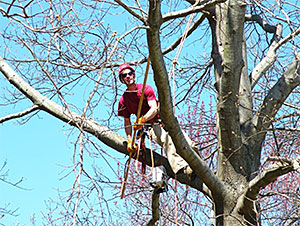Tree Pruning to ANSI Standards
 Winter is an excellent time to prune dead and hazardous branches out of trees, according to tree care experts. Why? It is easier to spot potential hazards such as cracks, defects and deadwood in leafless trees, and apply corrective pruning when necessary.
Winter is an excellent time to prune dead and hazardous branches out of trees, according to tree care experts. Why? It is easier to spot potential hazards such as cracks, defects and deadwood in leafless trees, and apply corrective pruning when necessary.
“Most trees can be pruned year-round, if pruned properly,” says Tchukki Andersen, BCMA, CTSP* and staff arborist for the Tree Care Industry Association. “However, certain pruning operations are easier to do in the winter, especially if the ground is frozen or the tree is not actively growing.”
Some homeowners worry that arborists will not be able to identify deadwood on a leafless tree. “On the contrary,” says Andersen. “This is the best time for an arborist to locate deadwood by looking for changes in branch color, fungus growth, cracks, and other symptoms that can help them make this determination. Since the leaves are off, the view of the entire tree’s architecture is clear and a thorough check can be performed.”
Pruning is much more than the simple act of sawing off limbs. Proper pruning is an art based on scientific principles of plant physiology. At its most basic level, pruning trees involves removing damaged, dead or structurally weak limbs, which will improve a tree’s health and reduce the chances of personal or property damage caused by falling limbs. More advanced pruning methods aid in improving the tree’s structure and long-term health.
Proper pruning encourages growth, increases flower and fruit production, improves plant health and removes damaged limbs, all which give aesthetic appeal to a tree. Pruning at the right time and in the right way is critical, since it is possible to kill a tree by neglect or over-pruning. Pruning at the wrong time can be damaging to tree tissues. The best time for tree health to prune would be in early spring following a carefully written pruning prescription.
How can a homeowner know if an arborist will prune a tree correctly?
“Ask the arborist if they prune according to the American National Standards Institute standard for tree pruning, which is called ANSI A300,” says Andersen.
This standard recommends, and in some cases requires, that the use of certain tools, cutting techniques and pruning methods be followed, and sets the standard definitions for terms the arborist will use in your estimate. Properly written work estimates for tree pruning should be written in accordance with ANSI A300 standards.
In addition to the information given on the work estimate, ANSI A300 sets some guidelines for basic pruning practices that arborists should follow.
Arborists adhering to the ANSI A300 pruning standard will not:
- leave branch stubs
- make unnecessary heading cuts
- cut off the branch collar (not make a flush cut)
- top or lion’s tail trees (stripping a branch from the inside leaving foliage just at the ends)
- remove more than 25 percent of the foliage of a single branch
- remove more than 25 percent of the total tree foliage in a single year
- damage other parts of the tree during pruning
- use wound paint
- prune without a good reason
- climb the tree with climbing spikes
Find a professional
A professional arborist can assess your landscape and work with you to determine the best and safest course of action for any work that needs to be done.